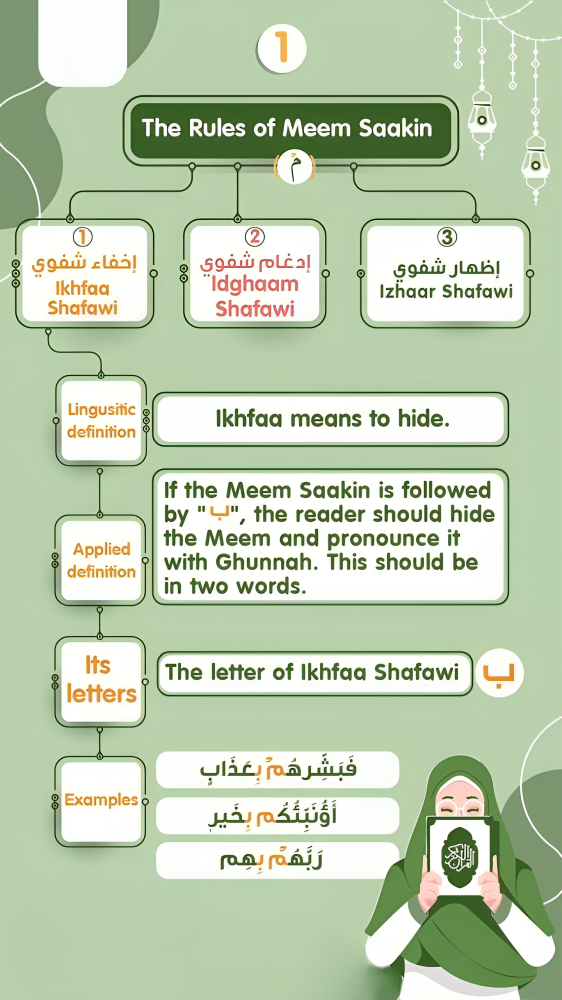A Tajweed-Based Guide for Quran Learners
The Arabic alphabet is more than just a script—it’s a sacred tool that connects you directly with the Kalam of Allah ﷻ. For every Muslim seeking closeness to the Quran, learning the correct articulation (makhraj) and pronunciation (sifaat) of each letter is essential.
Let’s explore the first seven letters—from Alif (ا) to Khaa (خ)—with deep understanding, Quranic references, and Tajweed principles.
1. Alif – ا
Arabic Form: ا
Name: Alif
Sound: Stretched “A” as in “apple”
Makharij: No independent sound. It elongates the Fatha ( ـَ ) before it.
Sifaat: Letter of Madd (مد), no sound without a harakah.
🔹 Tajweed Rule:
- Alif is always silent but used to stretch the vowel sound.
- When preceded by Fatha ( ـَ ), it becomes Madd Tabee’i and extends for 2 counts.
🔹 Qurani Example:
ٱللَّهُ لَآ إِلَـٰهَ إِلَّا هُوَ
“Allah – there is no deity except Him.” (Surah Al-Baqarah 2:255)
🔹 Tip: Alif is the base of elongation (Madd) and is not pronounced independently. It’s often mistaken by beginners as having a sound.
2. Baa – ب
Arabic Form: ب
Sound: Like “B” in “boy”
Makharij: Both lips closed together (الشفتان)
Sifaat:
- Rikhwah (soft)
- Jahr (non-whistling)
- Istifaal (light)
🔹 Tajweed Rule:
- A light letter (حرف مرقق), always pronounced softly.
- If followed by Meem, apply Ikhfa Shafawi.
- If with shaddah: strong press on the lips.
🔹 Qurani Example:
بِسْمِ ٱللَّهِ الرَّحْمَـٰنِ الرَّحِيمِ
“In the name of Allah, the Most Merciful, the Most Compassionate.” (Surah Al-Fatiha 1:1)
🔹 Common Mistake: Many confuse it with Meem (م); however, Baa has no nasal sound.
3. Taa – ت
Arabic Form: ت
Sound: Like “T” in “top”
Makharij: Tip of the tongue touches the upper front teeth (أطراف اللسان)
Sifaat:
- Hams (breath flows)
- Shiddah (strong press)
- Istifaal (light)
🔹 Tajweed Rule:
- Light letter, pronounced with clean breathy release.
- If joined with Seen or Seen letters, keep sharp clarity.
🔹 Qurani Example:
تَبَّتْ يَدَآ أَبِي لَهَبٍ
“Perish the hands of Abu Lahab!” (Surah Al-Masad 111:1)
🔹 Tip: Don’t press too long—just a clean sharp burst.
4. Thaa – ث
Arabic Form: ث
Sound: Like “Th” in “think”
Makharij: Tip of tongue between upper & lower teeth (طرف اللسان مع اطراف الثنايا)
Sifaat:
- Hams
- Rikhwah
- Istifaal
🔹 Tajweed Rule:
- Must be pronounced with tongue sticking slightly out.
- Soft letter; avoid making it like Seen (س).
🔹 Qurani Example:
ثُمَّ إِنَّكُمْ أَيُّهَا ٱلضَّآلُّونَ
“Then indeed, O you who are astray…” (Surah Al-Waqi’ah 56:51)
🔹 Common Error: Students replace it with Seen or Saad—incorrect makhraj!
5. Jeem – ج
Arabic Form: ج
Sound: Like “J” in “jam”
Makharij: Middle of the tongue touching the roof (وسط اللسان)
Sifaat:
- Qalqalah (echoing) letter, when sukoon applies.
- Jahr, Shiddah, Istifaal
🔹 Tajweed Rule:
- If Jeem has a sukoon, it echoes slightly (e.g., أَجْر).
- No heavy pronunciation—it’s a light letter.
🔹 Qurani Example:
جَنَّاتٍ تَجْرِي مِن تَحْتِهَا ٱلْأَنْهَـٰرُ
“Gardens beneath which rivers flow…” (Surah Al-Baqarah 2:25)
🔹 Student Tip: Be careful of over-emphasizing; it’s not a heavy letter.
6. Haa – ح
Arabic Form: ح
Sound: Deep breathy “H” (not English “H”)
Makharij: Middle of the throat (وسط الحلق)
Sifaat:
- Hams, Rikhwah, Istifaal
- No vibration, airy sound
🔹 Tajweed Rule:
- One of the Halqi (throaty) letters.
- Often appears with Meem and Nun for flowy recitation.
🔹 Qurani Example:
حَمِيمٍ
“Scalding water” (Surah Al-Ghashiyah 88:5)
🔹 Tip: Never pronounce like “Kha”; it’s softer and breathy.
7. Khaa – خ
Arabic Form: خ
Sound: Raspy “KH” like German “Bach”
Makharij: Upper throat (أقصى الحلق)
Sifaat:
- Tafkheem (Heavy)
- Hams
- Rikhwah
🔹 Tajweed Rule:
- Full mouth letter (مفخم) – round the mouth.
- Strong sound, especially when joined with Dhammah or Fatha.
🔹 Qurani Example:
خَالِدِينَ فِيهَآ أَبَدًۭا
“Abiding therein forever…” (Surah At-Tawbah 9:100)
🔹 Common Error: Beginners often confuse with Haa (ح). Practice with open throat.
📚 Summary Table
| Harf | Name | Sound | Makhraj | Sifat | Quranic Word |
|---|---|---|---|---|---|
| ا | Alif | A (long) | No sound | Madd | ٱللَّهُ |
| ب | Baa | B | Lips | Light | بِسْمِ |
| ت | Taa | T | Tip of tongue | Light | تَبَّتْ |
| ث | Thaa | Th | Tongue/teeth | Light | ثُمَّ |
| ج | Jeem | J | Mid-tongue | Light, Qalqalah | جَنَّاتٍ |
| ح | Haa | Breath H | Mid-throat | Light | حَمِيمٍ |
| خ | Khaa | KH | Upper throat | Heavy | خَالِدِينَ |
🌐 Why Global Students Choose Baytul Quran
Thousands of students from around the world—UK, USA, Canada, Australia, and the Middle East—are successfully learning to recite the Quran online with Baytul Quran because:
✅ Certified male & female teachers (Qaris & Hafiz)
✅ Special classes for kids, adults, and reverts
✅ Tajweed taught with clear visuals and live practice
✅ Individual attention and structured course paths
✅ Flexible timings for international students
✅ Lessons in English + Urdu + Arabic
🧒 Perfect for Kids, Reverts, & Working Professionals
Whether you’re a busy parent in Birmingham, a child in California, or a revert sister in Dubai—Baytul Quran’s online classes bring Quranic education to your fingertips, with love and Islamic adab.
💬 What Our Students Say
“I never thought my 6-year-old would read the Quran so fluently with Tajweed. JazakAllah Baytul Quran!” – Mother from London
“I’m a revert from Australia, and your teachers helped me pronounce every letter beautifully.” – Sister Fatima
“Professional teachers, affordable fees, and my son is excited for every class!” – Parent from Chicago
📱 Enroll Today — Start Your Quran Journey Now!
🔗 Website: www.baytulquran.com
📞 Pakistan: +92 300 8737779
📞 UK: +44 7842 064721
🔗 Follow Us for Updates & Free Quranic Content
📺 YouTube: Baytul Quran Channel
📘 Facebook: facebook.com/BaytulQuran1
📸 Instagram: @baytulquran_1
🌱 “The best among you are those who learn the Qur’an and teach it.” – Prophet Muhammad ﷺ (Bukhari)
🎙️ Prefer listening?
Play our English podcast to explore the first 7 Arabic letters with Tajweed and Quranic examples.





